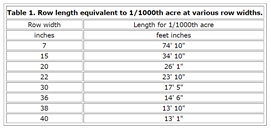Estimating Yield in Grain Corn

Estimating grain corn yield in any given field is exactly that – an estimate. The more samples and counts that are taken, the better variations in the field will be captured and accounted for. However, on that same note, no matter how many counts are done in a field, a variance of 20 bushels of yield (plus or minus) is a reasonable expectation.
A STEP-BY-STEP PROCESS FOR GRAIN CORN YIELD ESTIMATION:
1. Prior to sampling, determine how many samples or counts will be taken in each field. A minimum of 5 is recommended, 5 – 10 being appropriate. Of course, the more counts that are taken, the better representation of the field, overall.
- Tools needed: measuring tape, pen and paper. A calculator can be used in the field, or once all samples are completed, but will be required.
2. Enter the field and walk in several paces beyond the headlands. Pick a representative location to take the first count.
3. Measure a single row to the appropriate length of 1/1,000th of an acre. For the most common 30” row spacing, 17’5” is the appropriate length.
Figure 1: Row length required to measure 1/1,000th acre in various row widths
4. In the chosen 1/1,000th acre, count and record the number of harvestable ears on the plants. Do not count ears that have either dropped or may be on lodged plants and will not be picked up by the combine header.
5. Choose every 5th – 6th ear in the row and record the number of kernel rows and average kernels per row, and multiply the two factors for each chosen ear.
- Be sure to be selecting representative ears.
- Kernel rows are typically 12 – 18, but can be fewer or greater than that.
- Kernels per row – do not count aborted kernels; do not count the extreme base or tip kernels.
6. Add all counts together for the first site, then divide by number of sampled ears. For example, if 5 ears were sampled with kernel counts of 336, 384, 512, 496 and 600, the average number of kernels per ear: (350 + 380 + 510 + 500 + 625)/5 = 473
7. Yield for each sample site in one field is determined by multiplying ear number (Step 4) by the average number of kernels per ear (Step 6) and then dividing that total by 90. 90 represents the average number of kernels in a bushel of corn at 15.5% moisture (90,000). In a scenario where grain fill has exceptionally good, decrease that value to 80, and conversely, increase that number to 100 if grain fill has been particularly stressful and grain is lightweight.
Figure 2: Grain corn yield estimate formula – Iowa State University (https://crops.extension.iastate.edu/cropnews/2017/08/estimating-corn-yields-using-yield-components)
Formula example for sample site #1:
Let’s say 31 harvestable ears were counted at the first sample site.
- (31 harvestable ears * 473 kernels per ear)/90 = 163 bushels per acre for average/normal grain fill.
- (31 harvestable ears * 473 kernels per ear)/80 = 183 bushels per acre for exceptional grain fill.
- (31 harvestable ears * 473 kernels per ear)/100 = 147 bushels per acre for a below average grain fill.
Repeat this procedure 5 – 10 times throughout the field to get a good representative estimate and average the number of sites to yield calculations. Let’s say 7 sample sites were calculated:
(163 bu. + 182 bu. + 155 bu. + 159 bu. + 171 bu. + 176 bu. + 164 bu.)/ 7 sample sites = 167 bu/acre yield estimate for this grain corn field sampled.
REFERENCES:


